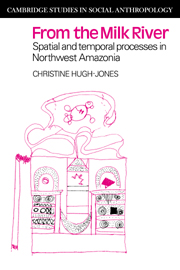Book contents
- Frontmatter
- Contents
- List of figures, tables and maps
- List of myths
- Preface
- Acknowledgements
- Orthography
- 1 Introduction
- 2 Social structure
- 3 The set of specialist roles
- 4 Kinship and marriage
- 5 The life-cycle
- 6 Production and consumption
- 7 Concepts of space–time
- 8 Conclusion
- Appendix 1 Named groups
- Appendix 2 Kinship terminology
- Works cited
- Index
- CAMBRIDGE STUDIES IN SOCIAL ANTHROPOLOGY
3 - The set of specialist roles
Published online by Cambridge University Press: 07 October 2009
- Frontmatter
- Contents
- List of figures, tables and maps
- List of myths
- Preface
- Acknowledgements
- Orthography
- 1 Introduction
- 2 Social structure
- 3 The set of specialist roles
- 4 Kinship and marriage
- 5 The life-cycle
- 6 Production and consumption
- 7 Concepts of space–time
- 8 Conclusion
- Appendix 1 Named groups
- Appendix 2 Kinship terminology
- Works cited
- Index
- CAMBRIDGE STUDIES IN SOCIAL ANTHROPOLOGY
Summary
Erosion of the system
The set of five specialist roles and the practical functioning, or lack of it, of the system have been briefly described already. This chapter is about the internal structure of the role-set and its analogy with other structures or processes.
First of all, the ideal behaviour associated with the roles must be presented in more detail. The difficulty with this, as suggested before, is that sib roles barely function at all at a practical level and therefore I am obliged to present a system, which above all applies to specialist groups, in terms of individual specialist roles. Of the specialist roles performed by individuals, there are only three that are well defined at present. These three are shaman, chanter and dancer, all of which belong to the metaphysical domain and all of which are recognised in a title added to the expert's personal name (thus X-kumu, Y-yoamʉ and Z-baya are shaman, chanter and dancer respectively). These three roles only cover two of the five roles in the complete set, since dancer and chanter belong to a single category. The others – chief, warrior and servant – must be described from indirect sources, including statements about the past. The content of the warrior role is the most problematic, for the ideal behaviour of chiefs and servants can be seen in attenuated form today as, for example, in the relationship between an important longhouse leader and a youthful ‘extra resident’.
- Type
- Chapter
- Information
- Publisher: Cambridge University PressPrint publication year: 1980

